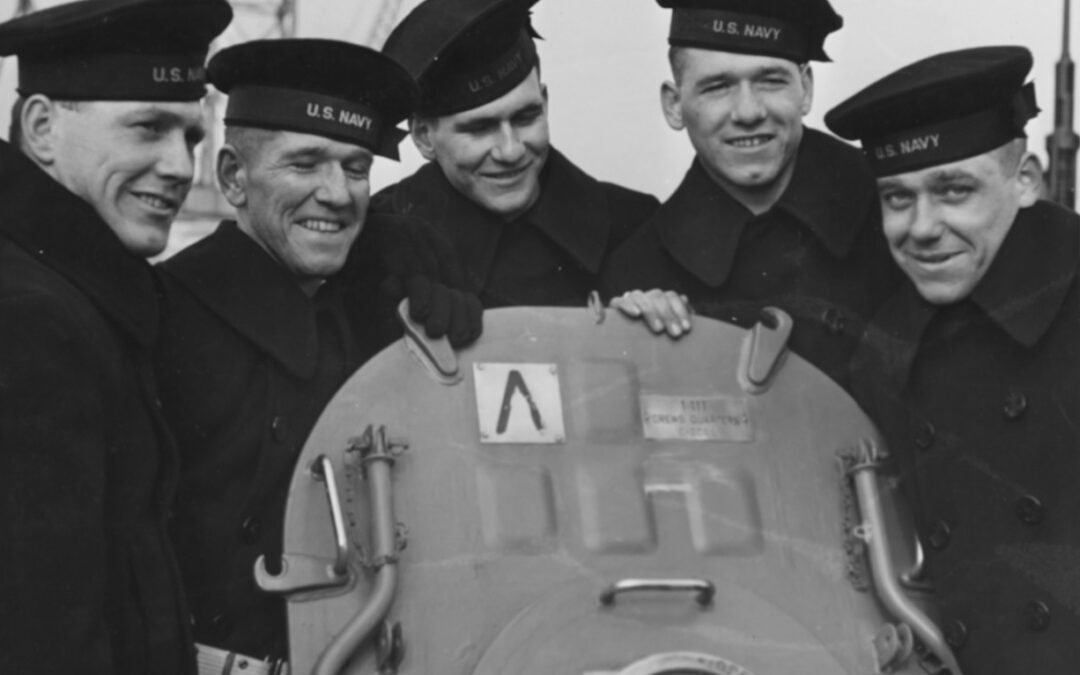Information from Naval History and Heritage Command.
All five of the Sullivan brothers from Waterloo, Iowa, were tragically killed in action on November 13, 1942 while serving aboard USS Juneau (CL-52). The death of the brothers was the biggest blow to any one family in U.S. wartime history.
Juneau initially served in the Atlantic, but was transferred to the Pacific in August 1942. Late in October 1942, she took part in the Battle of the Santa Cruz Islands and, on November 12, fought off Guadalcanal. In that action, a torpedo severely damaged the ship. The following morning, the crippled cruiser down by the bow and struggling to make 18 knots, retired from the battle area. Handling sluggishly as she limped through the glassy-calm sea, Juneau was an easy target for the nearby Japanese submarine I-26. A torpedo strike hit the damaged cruiser and detonated her magazines. The resulting explosion tore her apart, and she went down in just 42 seconds.
Four of the Sullivan brothers, Coxswain Francis Sullivan and Seamen 2nd Class Joseph, Madison, and Abel, failed to make it topside in time to abandon their doomed ship. Gunner’s Mate 2nd Class George Sullivan, wounded during the November 12 night action, managed to get over the side and pull himself onto a raft, but died of his wounds a few hours later. Only ten of approximately 140 were rescued from the ship.
George and Francis Sullivan—the two eldest—enlisted in the U.S. Navy on May 11, 1937, and served on the destroyer USS Hovey (DD-208) into June 1941. In Des Moines, Iowa, on January 3, 1942, George and Francis, accompanied by their younger brothers Joseph, Madison, and Albert, reenlisted to avenge the loss of Seaman 1st Class William V. Ball, a friend, who was killed while serving on the battleship USS Arizona (BB-39) during the Japanese attack on Pearl Harbor. After receiving initial training at the Naval Training School in Great Lakes, Illinois, all five brothers, at their expressed request, joined the light cruiser Juneau at the New York Navy Yard on February 3, 1942.
The brothers were survived by their parents, their only sister Genevieve, and the youngest brother’s wife and son, Katherine Sullivan and Jimmy.
There have been two ships named to honor the fallen brothers. The first, USS The Sullivans (DD-537), was commissioned on September 30, 1943. Her sponsor was the brothers’ mother, Alleta. The ship served in the U.S. Navy until she was decommissioned on January 7, 1965. She is currently a memorial at the Buffalo and Erie County Naval and Military Park in New York. The second ship, USS The Sullivans (DDG-68), was commissioned on April 19, 1997 at Staten Island, New York, under the command of Commander Gerard D. Ronocolato. The motto of the Arleigh Burke-class destroyer is “We Stick Together.” The ship is still active and is homeported in Mayport, Florida.
Since their loss, a lot of confusion has resulted from the many myths surrounding both the Sullivan brothers and the Navy’s policy regarding family members serving together at sea.
U.S. Navy Policy Regarding Family Members Serving Together at Sea
Several misconceptions, common during World War II and after, continue to circulate about the Sullivan brothers and the assignment of family members to U.S. Navy ships.
Reference to a “Sullivan Act” in connection with family members serving in the same ship/unit is a popular misconception. The Sullivan Law of May 29, 1911 is a New York State Law dealing with firearms. Although proposed after the death of the five Sullivan Brothers, no “Sullivan Act” was ever enacted by Congress related to family members serving together. Similarly, no President has ever issued any executive order forbidding assignment of family members to the same ship/unit.
Following are nine references that describe the U.S. Navy policy toward the assignment of family members to ships since 1942.
Official U.S. Navy Documents:
(1) Bureau of Naval Personnel Information Bulletin, 1942; Extract on the assignment of brothers to same ship or station
(2) Bureau of Naval Personnel Circular Letter 345-44, 15 November 1944; Sole-survivor policy
(3) Bureau of Naval Personnel Circular Letter 107-45, 14 April 1945; Sole-survivor policy
(4) Bureau of Naval Personnel Circular Letter 281-45, 28 September 1945; Members of Families Serving in the Same Ship, [Policy after World War II]
(5) Extract from History of Enlisted Personnel Activity, Bureau of Naval Personnel Administrative History, 1946. This summarizes wartime practice with regard to family members serving in same ship/unit, also “sole survivor” policy.
(6) Bureau of Naval Personnel Manual: Chapter 5; Policy on assignment or reassignment of members of the same immediate family, 1966.
(7) Naval Military Personnel Command Press Release , 29 May 1980; on same-unit and sole-survivor policies.
(8) OPNAV Instruction 1300.15, 6 January 1988 [Extract on sole survivors from Office of Chief of Naval Operations instruction]
(9) Naval Military Personnel Manual, NavPers 15560C, 15 August 1991
For more information regarding these references, visit this article from the Naval History and Heritage Command.

